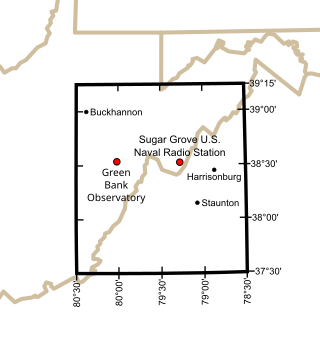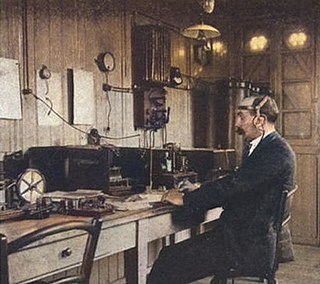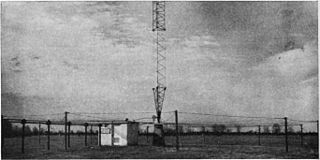
Karl Ferdinand Braun was a German electrical engineer, inventor, physicist and Nobel laureate in physics. Braun contributed significantly to the development of radio and television technology: he shared the 1909 Nobel Prize in Physics with Guglielmo Marconi "for their contributions to the development of wireless telegraphy", was a founder of Telefunken, one of the pioneering communications and television companies, and has been both called the "father of television" and the co-father of the radio telegraphy, together with Marconi.

Wi-Fi is a family of wireless network protocols based on the IEEE 802.11 family of standards, which are commonly used for local area networking of devices and Internet access, allowing nearby digital devices to exchange data by radio waves. These are the most widely used computer networks in the world, used globally in home and small office networks to link devices together and to a wireless router to connect them to the Internet, and in wireless access points in public places like coffee shops, hotels, libraries, and airports to provide visitors with Internet connectivity for their mobile devices.

Ultra high frequency (UHF) is the ITU designation for radio frequencies in the range between 300 megahertz (MHz) and 3 gigahertz (GHz), also known as the decimetre band as the wavelengths range from one meter to one tenth of a meter. Radio waves with frequencies above the UHF band fall into the super-high frequency (SHF) or microwave frequency range. Lower frequency signals fall into the VHF or lower bands. UHF radio waves propagate mainly by line of sight; they are blocked by hills and large buildings although the transmission through building walls is strong enough for indoor reception. They are used for television broadcasting, cell phones, satellite communication including GPS, personal radio services including Wi-Fi and Bluetooth, walkie-talkies, cordless phones, satellite phones, and numerous other applications.

Wireless communication is the transfer of information (telecommunication) between two or more points without the use of an electrical conductor, optical fiber or other continuous guided medium for the transfer. The most common wireless technologies use radio waves. With radio waves, intended distances can be short, such as a few meters for Bluetooth or as far as millions of kilometers for deep-space radio communications. It encompasses various types of fixed, mobile, and portable applications, including two-way radios, cellular telephones, personal digital assistants (PDAs), and wireless networking. Other examples of applications of radio wireless technology include GPS units, garage door openers, wireless computer mouse, keyboards and headsets, headphones, radio receivers, satellite television, broadcast television and cordless telephones. Somewhat less common methods of achieving wireless communications involve other electromagnetic phenomena, such as light and magnetic or electric fields, or the use of sound.
In United States regulatory law, an unintentional radiator is any device that is designed to use radio frequency electrical signals within itself, or sends radio frequency signals over conducting cabling to other equipment, but is not intended to radiate radio frequency energy. An incidental radiator is a device that can generate radio frequency electrical energy even though it is not intentionally designed to do so. Unintentional and incidental radio frequency radiation can interfere with other electronic devices. In the United States, limits on radiated emissions from unintentional and incidental radiators are established by the Federal Communications Commission. Similar regulations have been promulgated by other governments. Reference is usually made in regulations to technical standards established by organizations such as ANSI, IEC and ITU.
This is an index of articles relating to electronics and electricity or natural electricity and things that run on electricity and things that use or conduct electricity.

In radio communication, an omnidirectional antenna is a class of antenna which radiates equal radio power in all directions perpendicular to an axis, with power varying with angle to the axis, declining to zero on the axis. When graphed in three dimensions (see graph) this radiation pattern is often described as doughnut-shaped. Note that this is different from an isotropic antenna, which radiates equal power in all directions, having a spherical radiation pattern. Omnidirectional antennas oriented vertically are widely used for nondirectional antennas on the surface of the Earth because they radiate equally in all horizontal directions, while the power radiated drops off with elevation angle so little radio energy is aimed into the sky or down toward the earth and wasted. Omnidirectional antennas are widely used for radio broadcasting antennas, and in mobile devices that use radio such as cell phones, FM radios, walkie-talkies, wireless computer networks, cordless phones, GPS, as well as for base stations that communicate with mobile radios, such as police and taxi dispatchers and aircraft communications.
Code of Federal Regulations, Title 47, Part 15 is an oft-quoted part of Federal Communications Commission (FCC) rules and regulations regarding unlicensed transmissions. It is a part of Title 47 of the Code of Federal Regulations (CFR), and regulates everything from spurious emissions to unlicensed low-power broadcasting. Nearly every electronics device sold inside the United States radiates unintentional emissions, and must be reviewed to comply with Part 15 before it can be advertised or sold in the US market.

The National Radio Quiet Zone (NRQZ) is a large area of land in the United States designated as a radio quiet zone, in which radio transmissions are restricted by law to facilitate scientific research and the gathering of military intelligence. About half of the zone is located in the Blue Ridge Mountains of west-central Virginia while the other half is in the Allegheny Mountains of east-central West Virginia; a small part of the zone is in the southernmost tip of the Maryland panhandle.

Grimeton Radio Station in southern Sweden, close to Varberg in Halland, is an early longwave transatlantic wireless telegraphy station built in 1922–1924, that has been preserved as a historical site. From the 1920s through the 1940s it was used to transmit telegram traffic by Morse code to North America and other countries, and during World War II was Sweden's only telecommunication link with the rest of the world. It is the only remaining example of an early pre-electronic radio transmitter technology called an Alexanderson alternator. It was added to the UNESCO World Heritage List in 2004, with the statement: "Grimeton Radio Station, Varberg is an outstanding monument representing the process of development of communication technology in the period following the First World War." The radio station is also an anchor site for the European Route of Industrial Heritage. The transmitter is still in operational condition, and each year on a day called Alexanderson Day is started up and transmits brief Morse code test transmissions, which can be received all over Europe.

A thermostatic radiator valve (TRV) is a self-regulating valve fitted to hot water heating system radiator, to control the temperature of a room by changing the flow of hot water to the radiator.

Radio masts and towers are typically tall structures designed to support antennas for telecommunications and broadcasting, including television. There are two main types: guyed and self-supporting structures. They are among the tallest human-made structures. Masts are often named after the broadcasting organizations that originally built them or currently use them.

A mast radiator is a radio mast or tower in which the metal structure itself is energized and functions as an antenna. This design, first used widely in the 1930s, is commonly used for transmitting antennas operating at low frequencies, in the LF and MF bands, in particular those used for AM radio broadcasting stations. The conductive steel mast is electrically connected to the transmitter. Its base is usually mounted on a nonconductive support to insulate it from the ground. A mast radiator is a form of monopole antenna.
Packet loss occurs when one or more packets of data travelling across a computer network fail to reach their destination. Packet loss is either caused by errors in data transmission, typically across wireless networks, or network congestion. Packet loss is measured as a percentage of packets lost with respect to packets sent.

The invention of radio communication was preceded by many decades of establishing theoretical underpinnings, discovery and experimental investigation of radio waves, and engineering and technical developments related to their transmission and detection. These developments allowed Guglielmo Marconi to turn radio waves into a wireless communication system.

An umbrella antenna is a capacitively top-loaded wire monopole antenna, consisting in most cases of a mast fed at the ground end, to which a number of radial wires are connected at the top, sloping downwards. They are used as transmitting antennas below 1 MHz, in the MF, LF and particularly the VLF bands, at frequencies sufficiently low that it is impractical or infeasible to build a full size quarter-wave monopole antenna. The outer end of each radial wire, sloping down from the top of the antenna, is connected by an insulator to a supporting rope or (usually) insulated cable anchored to the ground; the radial wires can also support the mast as guy wires. The radial wires make the antenna look like the wire frame of a giant umbrella hence the name.
UKC Radio was the student radio station for the University of Kent at Canterbury (UKC). it began life in 1967 as an audio distribution system through the central heating radiators before obtaining a broadcast licence in 1968, at which point it was operated as a student service by the University of Kent Students' Union.

Wireless speakers are loudspeakers that receive audio signals using radio frequency (RF) waves rather than over audio cables. The two most popular RF frequencies that support audio transmission to wireless loudspeakers include a variation of WiFi IEEE 802.11, while others depend on Bluetooth to transmit audio data to the receiving speaker.

An Austin ring transformer is a special type of isolation transformer with low capacitance and high isolation between the primary and secondary. It is formed of two interlocking rings: one with the transformer core and primary windings, much like a conventional toroidial transformer and the other with the secondary windings. It is used for providing power to the aircraft warning lights and other devices on a mast radiator antenna insulated from ground. In the Austin transformer the primary and secondary windings are separated by an air gap, so that the high voltage on the mast cannot get into the low voltage lighting supply wiring, causing safety hazards. It is named after its inventor, Arthur O. Austin, who graduated from Stanford University in 1903 and who obtained 225 patents in his career.

In electronics and radio communication, a counterpoise is a network of suspended horizontal wires or cables, used as a substitute for an earth (ground) connection in a radio antenna system. It is used with radio transmitters or receivers when a normal earth ground cannot be used because of high soil resistance or when an antenna is mounted above ground level, for example, on a building. It usually consists of a single wire or network of horizontal wires, parallel to the ground, suspended above the ground under the antenna, connected to the receiver or transmitter's "ground" wire. The counterpoise functions as one plate of a large capacitor, with the conductive layers of the earth acting as the other plate.














